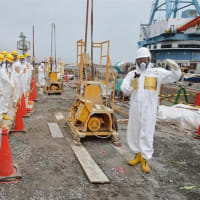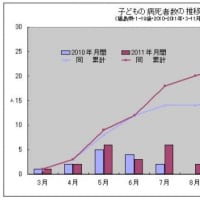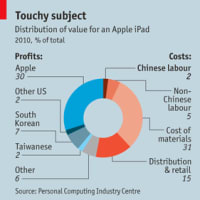経済が成長するには、産業が発展する必要がありますな。国として、成長戦略を持つ必要がある、なんて言われたりしますが、
政府が産業振興を行うにあたって、どんな役割を果たすべきなのか。
オバマさんは、経済刺激策として、個別の企業にも踏み込んで支援をしてきたわけですが、そのうちの一社が法的な破綻をした、というニュースなんですな。
チャプター11の申請なので、営業を継続しながら再生を目指すという形です。
Solar Company Failure Shows Less Federal Aid Works Better: View
Sept. 8 (Bloomberg) -- The worst and best of U.S. government policy on solar energy has been on display lately. In a cringe-worthy failure, California solar-panel maker Solyndra filed for bankruptcy this week, just two years after winning $535 million of federal loan guarantees.
最近、最悪と最善の米政府の太陽光エネルギー政策が明るみなった。ヤバイ大失敗をやらかして、カリフォルニアのソーラーパネルメーカーのソリンドラが今週、倒産申請をしたのだ。これは535百万ドルの政府保証借り入を勝ち取って丁度2年後のことだ。
Solyndra’s rapid rise and fall should have played out entirely in the private sector. Silicon Valley is thick with venture capitalists willing to finance risky, iconoclastic startups.
ソリンドラの早かった興亡については全て私的部門の中で行われるべきだった。シリコンバレーには層の厚いベンチャーキャピタリストが存在する。
Indeed, Solyndra raised a staggering $1.1 billion from private sources since its founding in 2005. The extra federal support ended up having the well-intentioned but unfortunate effect of allowing the company to ramp up manufacturing quickly, even as evidence was emerging that it had badly misread the changing economics of the solar-panel market.
実際、ソリンドラは05年に設立されてから11億ドルを集めている。ソーラーパネルマーケットが既に変化しつつあるのを当社が読み間違えているとの証拠が出始めているにもかかわらず、政府の支援が当社の製造能力増強を早期化させるという不幸な結果に終わった。
A few years ago, prices for the silicon wafers used in most flat-panel solar systems were soaring. Solyndra proposed building an entirely different panel, using tubes coated with thin films of copper-indium-gallium-selenide that would pick up light from any direction.
数年前、ソーラーシステムで使われるシリコンウエハの価格は上昇していた。ソリンドラは全く異なるパネル、つまり薄いフィルムで覆われた全方位から光を吸収するチューブを使うことを提案。
Solyndra predicted that its tubes would be far cheaper than the silicon alternative. No such luck. Silicon prices have plunged nearly 90 percent from their peak in 2008, making conventional panels the better bargains.
ソリンドラはシリコンを使うよりずっと安いと予想。
しかしそうはならなかった。シリコン価格は08年のピークから9割も下落し、従来パネルでもいい感じになってしまった。
A day after Solyndra’s failure, it was heartening to see the Department of Energy award a total of $145 million to 69 solar energy projects taking place inside universities, government research labs and major corporations. Many of those grants are for as little as $750,000 apiece, and none is larger than $13 million. Each targets a current impediment to cheaper solar power -- and then provides initial support for a dozen or more different ideas that might lead to breakthroughs.
ソリンドラの失敗の後日、エネルギー省は大学や政府や大企業の研究機関の69の太陽光エネルギープロジェクトに145百万ドルを与えた。そのほとんどは一件750千ドル程度で、13百万ドルを超えない。それぞれは、ソーラーパネルのコスト低減を目標としており、それら異なるいくつものアイディアに初期の支援をすることで、そのうちどれかが成功するかも知れない。
Steering small amounts of money to many early-stage researchers is the best way for government to operate. Misfires don’t cost much. Successes can be huge. Private-financing alternatives are patchy at best, because these researchers’ ideas might not pay off for a decade or more. The benefits of this sort of pioneering government support can be seen in the Defense Department’s early work on computer networks, which helped make the Internet possible.
少額の資金を沢山の初期の研究に与えるというやり方は政府の施策として最も優れている。失敗しても大きくない。成功は大きい。そうした段階での民間での資金調達は、せいぜいうまく行ったり行かなかったりだ。研究者のアイディアは10年以上ペイしないかも知れないからだ。初期研究に投資する政府の役割は、国防省の初期の実績にみることができる。コンピュータネットワークへのサポートはインターネットを可能にしたのだ。
Solyndra’s stumbles, on the other hand, underscore how poorly governments fare when they try too hard to pick industrial winners.
一方で、ソリンドラのつまづきは、政府が産業での勝利者を選ぼうとしてやりすぎると、どんなヘマをするかが良くわかる。
当然ながら、これは日本にあっても、言えることですよね。
Solyndra solar power company shuts down 15 months after Obama visit and Energy Department stimulus!!
政府が産業振興を行うにあたって、どんな役割を果たすべきなのか。
オバマさんは、経済刺激策として、個別の企業にも踏み込んで支援をしてきたわけですが、そのうちの一社が法的な破綻をした、というニュースなんですな。
チャプター11の申請なので、営業を継続しながら再生を目指すという形です。
Solar Company Failure Shows Less Federal Aid Works Better: View
Sept. 8 (Bloomberg) -- The worst and best of U.S. government policy on solar energy has been on display lately. In a cringe-worthy failure, California solar-panel maker Solyndra filed for bankruptcy this week, just two years after winning $535 million of federal loan guarantees.
最近、最悪と最善の米政府の太陽光エネルギー政策が明るみなった。ヤバイ大失敗をやらかして、カリフォルニアのソーラーパネルメーカーのソリンドラが今週、倒産申請をしたのだ。これは535百万ドルの政府保証借り入を勝ち取って丁度2年後のことだ。
Solyndra’s rapid rise and fall should have played out entirely in the private sector. Silicon Valley is thick with venture capitalists willing to finance risky, iconoclastic startups.
ソリンドラの早かった興亡については全て私的部門の中で行われるべきだった。シリコンバレーには層の厚いベンチャーキャピタリストが存在する。
Indeed, Solyndra raised a staggering $1.1 billion from private sources since its founding in 2005. The extra federal support ended up having the well-intentioned but unfortunate effect of allowing the company to ramp up manufacturing quickly, even as evidence was emerging that it had badly misread the changing economics of the solar-panel market.
実際、ソリンドラは05年に設立されてから11億ドルを集めている。ソーラーパネルマーケットが既に変化しつつあるのを当社が読み間違えているとの証拠が出始めているにもかかわらず、政府の支援が当社の製造能力増強を早期化させるという不幸な結果に終わった。
A few years ago, prices for the silicon wafers used in most flat-panel solar systems were soaring. Solyndra proposed building an entirely different panel, using tubes coated with thin films of copper-indium-gallium-selenide that would pick up light from any direction.
数年前、ソーラーシステムで使われるシリコンウエハの価格は上昇していた。ソリンドラは全く異なるパネル、つまり薄いフィルムで覆われた全方位から光を吸収するチューブを使うことを提案。
Solyndra predicted that its tubes would be far cheaper than the silicon alternative. No such luck. Silicon prices have plunged nearly 90 percent from their peak in 2008, making conventional panels the better bargains.
ソリンドラはシリコンを使うよりずっと安いと予想。
しかしそうはならなかった。シリコン価格は08年のピークから9割も下落し、従来パネルでもいい感じになってしまった。
A day after Solyndra’s failure, it was heartening to see the Department of Energy award a total of $145 million to 69 solar energy projects taking place inside universities, government research labs and major corporations. Many of those grants are for as little as $750,000 apiece, and none is larger than $13 million. Each targets a current impediment to cheaper solar power -- and then provides initial support for a dozen or more different ideas that might lead to breakthroughs.
ソリンドラの失敗の後日、エネルギー省は大学や政府や大企業の研究機関の69の太陽光エネルギープロジェクトに145百万ドルを与えた。そのほとんどは一件750千ドル程度で、13百万ドルを超えない。それぞれは、ソーラーパネルのコスト低減を目標としており、それら異なるいくつものアイディアに初期の支援をすることで、そのうちどれかが成功するかも知れない。
Steering small amounts of money to many early-stage researchers is the best way for government to operate. Misfires don’t cost much. Successes can be huge. Private-financing alternatives are patchy at best, because these researchers’ ideas might not pay off for a decade or more. The benefits of this sort of pioneering government support can be seen in the Defense Department’s early work on computer networks, which helped make the Internet possible.
少額の資金を沢山の初期の研究に与えるというやり方は政府の施策として最も優れている。失敗しても大きくない。成功は大きい。そうした段階での民間での資金調達は、せいぜいうまく行ったり行かなかったりだ。研究者のアイディアは10年以上ペイしないかも知れないからだ。初期研究に投資する政府の役割は、国防省の初期の実績にみることができる。コンピュータネットワークへのサポートはインターネットを可能にしたのだ。
Solyndra’s stumbles, on the other hand, underscore how poorly governments fare when they try too hard to pick industrial winners.
一方で、ソリンドラのつまづきは、政府が産業での勝利者を選ぼうとしてやりすぎると、どんなヘマをするかが良くわかる。
当然ながら、これは日本にあっても、言えることですよね。
Solyndra solar power company shuts down 15 months after Obama visit and Energy Department stimulus!!




















※コメント投稿者のブログIDはブログ作成者のみに通知されます